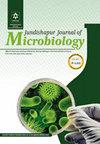Co-prevalence of Human Parvovirus 4 and Primate Erythroparvovirus 1 (B19) in Sickle Cell Disease and Healthy Populations
IF 0.5
4区 医学
Q4 MICROBIOLOGY
引用次数: 0
Abstract
Background: Human Parvovirus 4 (P4) is a non-enveloped, single-stranded DNA virus belonging to the Tetraparvovirus genus within the Parvoviridae family. Epidemiologically, P4 exhibits similarities with its well-established family counterpart, primate erythroparvovirus 1 (known as B19), a blood-borne virus implicated in causing aplastic crises in individuals with sickle cell disease (SCD). Despite the acknowledged association with B19, there is a dearth of prior investigations into the prevalence and clinical significance of P4 in SCD patients. Objectives: This study aims to ascertain the prevalence and outcomes of P4, along with exploring the co-prevalence of P4 with B19 in individuals with SCD. Methods: A total of 162 participants were enrolled, comprising 120 individuals with SCD and 45 healthy controls. The prevalence of P4 and B19 DNA was determined utilizing a nested-PCR method. Sequencing was performed on positive samples to validate the diagnosis, and a phylogenetic tree was constructed based on the sequencing results. Correlations in the data were analyzed using statistical methods. Results: The prevalence of P4 and B19, as well as the co-prevalence of these viruses, was significantly higher in SCD patients than in healthy individuals. Moreover, the prevalence of P4 did not exhibit a significant correlation with variables such as age, sex, aplastic crises, or specific complications associated with SCD. Conclusions: Sickle cell disease patients represent a susceptible population for P4 infection, as indicated by the heightened prevalence observed in this study.镰状细胞病和健康人群中人类 Parvovirus 4 和灵长类红细胞病毒 1 (B19) 的共患病率
背景:人类副粘病毒4(P4)是一种无包膜、单链DNA病毒,属于副粘病毒科四副粘病毒属。在流行病学上,P4与其家族中公认的对应病毒灵长类红细胞病毒1(又称B19)有相似之处,B19是一种血液传播病毒,可导致镰状细胞病(SCD)患者出现再生障碍性危象。尽管 B19 与镰状细胞病的关系已得到公认,但此前对 P4 在 SCD 患者中的流行情况和临床意义的调查却十分匮乏。研究目的本研究旨在确定 P4 的患病率和结果,同时探讨 P4 与 B19 在 SCD 患者中的共患病率。研究方法共招募了 162 名参与者,其中包括 120 名 SCD 患者和 45 名健康对照者。采用巢式 PCR 方法测定 P4 和 B19 DNA 的流行率。对阳性样本进行测序以验证诊断结果,并根据测序结果构建系统发生树。使用统计方法分析了数据中的相关性。结果P4和B19病毒在SCD患者中的流行率以及这些病毒的共患病率均明显高于健康人。此外,P4 的流行率与年龄、性别、再生障碍性危机或与 SCD 相关的特定并发症等变量没有明显的相关性。结论是镰状细胞病患者是 P4 感染的易感人群,本研究中观察到的高患病率就说明了这一点。
本文章由计算机程序翻译,如有差异,请以英文原文为准。
求助全文
约1分钟内获得全文
求助全文
来源期刊

Jundishapur Journal of Microbiology
MICROBIOLOGY-
CiteScore
1.30
自引率
0.00%
发文量
56
审稿时长
6-12 weeks
期刊介绍:
Jundishapur Journal of Microbiology, (JJM) is the official scientific Monthly publication of Ahvaz Jundishapur University of Medical Sciences. JJM is dedicated to the publication of manuscripts on topics concerning all aspects of microbiology. The topics include medical, veterinary and environmental microbiology, molecular investigations and infectious diseases. Aspects of immunology and epidemiology of infectious diseases are also considered.
文献相关原料
| 公司名称 | 产品信息 | 采购帮参考价格 |
|---|
 求助内容:
求助内容: 应助结果提醒方式:
应助结果提醒方式:


